
A company will be able to quickly assess whether it has borrowed too much money, whether the assets it owns are not liquid enough, or whether it has enough cash on hand to meet current demands. However, if you decide to create a journal entry, you should enter a date of the end of the time period, and set it to reverse on the following day. For invoices, the journal entry debits the account affected by the invoice and credits accounts receivable, while, for bill entries, it credits the asset account and debits accounts payable.
JD.com Announces Second Quarter and Interim 2023 Results – JD.com
JD.com Announces Second Quarter and Interim 2023 Results.
Posted: Wed, 16 Aug 2023 07:00:00 GMT [source]
AR turnover is calculated by dividing its total sales on credit over a period of time by its average accounts receivable balance during that time. A high number here indicates that the company is effective at collecting its receivables from customers. The term balance sheet refers to a financial statement that reports a company’s assets, liabilities, and shareholder equity at a specific point in time. Balance sheets provide the basis for computing rates of return for investors and evaluating a company’s capital structure. On the other hand, Notes Receivable are contracts that are usually signed by both the entity and its debtor.
Enter your name and email in the form below and download the free template now! You can use the Excel file to enter the numbers for any company and gain a deeper understanding of how balance sheets work. Notes Receivable should initially be measured at the Fair Value. Fair Value is the present value of the future cash flows, discounted using the market interest rate.
What Are the Uses of a Balance Sheet?
And results in a $100 in accounts receivable balance because the customer will owe you in the future. You see the double entry system – sales are on the income statement; accounts receivable is on the balance sheet. Suppose XYZ Company agrees to sell $500,000 worth of its product to customer ABC on net 90 terms—meaning the customer has 90 days to pay.
Fuji Oil : Sep. 06,2023 Consolidated Financial Results for the Three Months Ended June 30, 2023 (Under Japanese GAAP) (114KB) – Marketscreener.com
Fuji Oil : Sep. 06,2023 Consolidated Financial Results for the Three Months Ended June 30, 2023 (Under Japanese GAAP) (114KB).
Posted: Wed, 06 Sep 2023 08:54:02 GMT [source]
It is also known as net assets since it is equivalent to the total assets of a company minus its liabilities or the debt it owes to non-shareholders. A liability is any money that a company owes to outside parties, from bills it has to pay to suppliers to interest on bonds issued to creditors to rent, utilities and salaries. Current liabilities are due within one year and are listed in order of their due date. Long-term liabilities, on the other hand, are due at any point after one year. Accounts within this segment are listed from top to bottom in order of their liquidity. They are divided into current assets, which can be converted to cash in one year or less; and non-current or long-term assets, which cannot.
Any significant addition or deletion shall be explained in a note. The method by which amounts are removed from inventory (e.g., average cost, first-in, first-out, last-in, first-out, estimated average cost per unit) shall be described. The reason they are important is not just because they are important. The two statements actually have a relationship – one affects the other.
Upgrading to a paid membership gives you access to our extensive collection of plug-and-play Templates designed to power your performance—as well as CFI’s full course catalog and accredited Certification Programs. At the end of the three months, the note, with interest, is completely paid off. Similarly, Other Receivables also reflect the amount owed by the business by non-trading elements. This is any other receivable that the company has that does not fall under the day-to-day operations or selling of the business.
Stock Option Compensation-2
For example, a positive change in plant, property, and equipment is equal to capital expenditure minus depreciation expense. If depreciation expense is known, capital expenditure can be calculated and included as a cash outflow under cash flow from investing in the cash flow statement. Inventory includes amounts for raw materials, work-in-progress goods, and finished goods.

If the commitment is subsequently exercised during the commitment period, the remaining unamortized commitment fee at the time of exercise shall be recognized over the life of the loan as an adjustment of yield. The term remote is used here, consistent with its use in Topic 450, to mean that the likelihood is slight that a loan commitment will be exercised before its expiration. The note has now been xero review completely paid off, and ABC has recorded a total of $246 in interest income over a three-month period. This requires companies to write off this amount from assets and then expense it to reflect an incidence of loss in the company’s books. For example, interest revenue receivable and returns from any other sources of income that need to be received by the company are categorized as other receivable.
Notes Receivable Explained
Accounts receivables, like cash, are considered a current assets. An asset is something of value that a company owns or controls. Accounts receivables are considered valuable because they represent money that is contractually owed to a company by its customers. Low levels of receivables coupled with low sales growth rates are another cause for concern, as this sometimes means that the company’s finance department isn’t competitive with its terms. This balance sheet also reports Apple’s liabilities and equity, each with its own section in the lower half of the report. The liabilities section is broken out similarly as the assets section, with current liabilities and non-current liabilities reporting balances by account.
- (2) Amounts representing the recognized sales value of performance and such amounts that had not been billed and were not billable to customers at the date of the balance sheet.
- If Walmart were to go bankrupt or simply not pay, the seller would be forced to write off the A/R balance on its balance sheet by $1.5 million.
- The main objective is to collect quickly because of this accounts receivables are “current” or short-term assets.
- This is any other receivable that the company has that does not fall under the day-to-day operations or selling of the business.
If accounts receivable is not settled, and the customers default or go bankrupt, the amount is then supposed to be written off from the books. (c) If the LIFO inventory method is used, the excess of replacement or current cost over stated LIFO value shall, if material, be stated parenthetically or in a note to the financial statements. Accounts receivable is located in the asset section of the balance sheet usually right underneath cash or bank accounts. Accounts receivable is the next best thing to cash so it is highly important by being near the top of the balance sheet. Accounts receivable is located in the asset section of the balance sheet usually right underneath cash or bank accounts and is the next best thing to cash.
Notes Receivable
Moving down the balance sheet above you see some other current assets like inventory. Inventory is an asset that remains on your shelf until you sell it. Because it is a physical asset and you have to sell it, it typically does take longer to convert it to cash so it comes underneath accounts receivables. But it is still anticipated that you will convert the inventory into a sale within a one-year period so it is classified as current.
On the other hand, Other Receivables can be defined as the amount that needs to be recovered from other parties that the business is in touch with. Additional paid-in capital and other additional capital may be combined with the stock caption to which it applies, if appropriate. Bonds, mortgages and other long-term debt, including capitalized leases. (4) With respect to (1) through (3) above, also state the amounts included in each item which are expected to be collected after one year. Also state, by year, if practicable, when the amounts of retainage (see (1) above) are expected to be collected. It can be sold at a later date to raise cash or reserved to repel a hostile takeover.
Specifically, a note receivable is a written promise to receive money at a future date. On a company’s balance sheet, the accounts receivable line represents money the company is owed by its customers for goods or services rendered. After receiving payment the company will reclassify the cash on its balance sheet by debiting the cash account and crediting the accounts receivable account. https://online-accounting.net/ Note receivable is a balance sheet item that records the value of promissory notes that a business is owed and should receive payment for. If the note receivable is due within a year, then it is treated as a current asset on the balance sheet. If it is not due until a date that is more than one year in the future, then it is treated as a non-current asset on the balance sheet.
- Accounts Payables, or AP, is the amount a company owes suppliers for items or services purchased on credit.
- It divides the company’s credit sales in a given period by its average A/R during the same period.
- The financial statement only captures the financial position of a company on a specific day.
- A company lends one of its important suppliers $10,000 and the supplier gives the company a written promissory note to repay the amount in six months along with interest at 8% per year.
- The higher a firm’s accounts receivable balance, the less cash it has realized from sales activities.
Entities that anticipate prepayments in applying the interest method shall disclose that policy and the significant assumptions underlying the prepayment estimates. If these notes are due for more than one year, it is referred to as a Non-Current Asset in that particular case. Similarly, it also helps to decide on the future trajectory regarding the credit limit that needs to be extended and other relevant credit-related policies. Using these, the company’s overall performance and liquidity position can be reasonably estimated.
What is the accounts receivable turnover ratio?
Amortized cost is the initial value of the Notes Receivable (which were initially recorded at Fair Value) less any principal repayments and then adjusted for amortization of the premium and any impairment. A loan is impaired when, based on current information and events, it is probable that a creditor will be unable to collect all amounts due according to the contractual terms of the loan agreement. NetSuite has packaged the experience gained from tens of thousands of worldwide deployments over two decades into a set of leading practices that pave a clear path to success and are proven to deliver rapid business value.
The balance sheets and other financial statements of these companies must be prepared in accordance with Generally Accepted Accounting Principles (GAAP) and must be filed regularly with the Securities and Exchange Commission (SEC). A company usually must provide a balance sheet to a lender in order to secure a business loan. A company must also usually provide a balance sheet to private investors when attempting to secure private equity funding.